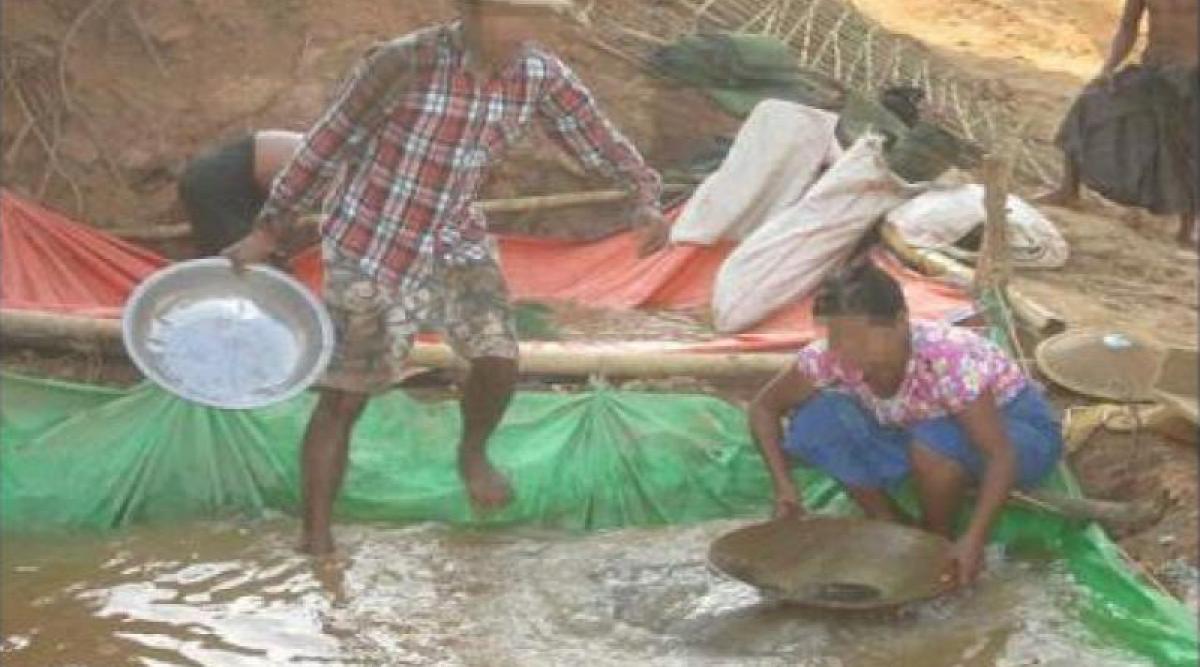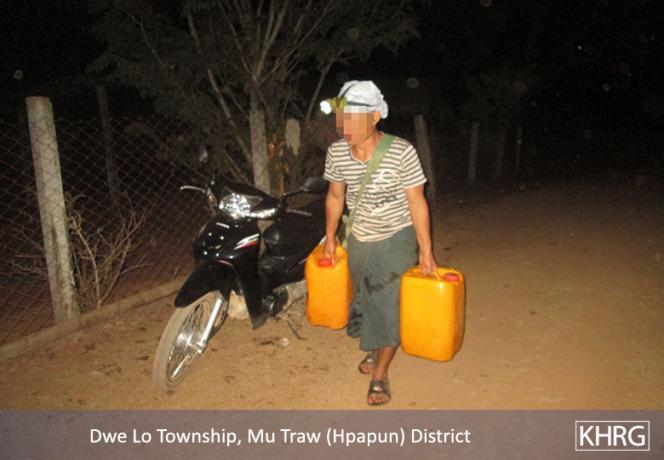This Situation Update describes events occurring in Bu Tho Township, Hpapun District during the period between December 2016 and February 2017. It includes information on Tatmadaw military activities, land administration and water contamination due to gold mining in a local river.
- In December 2016, Tatmadaw officers from Light Infantry Battalion (LIB) # 434 demanded five bowls of rice for every acre of agricultural land owned by the local community. The local farmers all refused to give in to the Tatmadaw’s demands.
- Wealthy villagers came together to mine gold in the Meh Kleh River, close to D--- village. The local community uses this part of the river as an irrigation channel. Because of chemical contamination, agricultural lands have been destroyed and there is a shortage of clean drinking water in the area.
Situation Update | Bu Tho Township, Hpapun District (December to February 2017)
The following Situation Update was received by KHRG in April 2017. It was written by a community member in Hpapun District who has been trained by KHRG to monitor human rights conditions. It is presented below translated exactly as originally written, save for minor edits for clarity and security.[1] This report was received along with other information from Hpapun District, including four interviews, 69 photographs and 9 video clips.[2]
Introduction
This Situation Update describes events that occurred in Bu Tho Township between December 2016 and February 2017. This report includes information about Tatmadaw military activity, land administration, gold mining, and development projects.
Tatmadaw Military Activity
In December 2016, during the harvest, a Tatmadaw officer demanded rice from farmers whose paddy fields are close to the Light Infantry Battalion (LIB) # 434 army camp.[3] His soldiers ordered local farmers to give them five baskets of rice for each acre of their paddy fields. The villagers were told that if they did not give rice to the soldiers, they would have to pay them 5,000 kyat [USD 3.73][4] per basket of rice instead.
The local farmers got together to discuss the Tatmadaw’s demands. They decided that none of them will hand out rice to the Tatmadaw soldiers. The villagers said that they would not give in to any of their demands because they had already paid their taxes. In the end, they did not give in to any of the Tatmadaw’s demands.
According to a Tatmadaw commander, the soldiers demanded the rice for their personal consumption. These actions were taken outside of the formal military command. The names of the soldiers who demanded rice from the local community are unknown.
In February 2017, the Tatmadaw LIB # 434, LIB # 341, LIB # 340, and IB # 19[5] started digging trenches. They also set up huts for shelter beside the jungle and not by the road. According to a local villager who was looking after his cattle while it was grazing in the area, the community was worried about this. [This is because the Tatmadaw usually builds their shelters close to the road].
There are six farmlands located near the LIB # 434 army base. Farmers are concerned that they may not be able to farm on this land next year. The LIB # 434 extended their camp to as little as 75 feet proximity to villagers’ farmlands. Villagers said that the Tatmadaw did not build their army [camps] so close to the lands of the local community in the past.
Land Administration
In December 2016, during the harvest, representatives from the Ministry of Agriculture, Livestock, and Irrigation came to Hpapun District to measure land used as a paddy field. They demarcated a parcel of land of six square feet. Then, they cut all of the rice plants growing on this parcel and took the plants for testing.
After this incident, the representatives [from the Ministry of Agriculture, Livestock, and Irrigation] asked the local villagers to switch to using the rice paddies that were produced in urban areas. However, the local could not adopt this [request] because their fields were not wide enough and had an insufficient water supply. An officer from the Department of Agriculture, Livestock, and Irrigation, named Htin Lin, came to the farmland every day. If farmers were harvesting rice near the vehicle road, he would often ask his staff to fetch a rice paddy for him [to test the plant]. No compensation was provided to the farmers.
The Karen National Union (KNU) did not engage much in land administration activities. However, between January and March 2017, there were minor issues related to the land measurements conducted by [the KNU] Land Department. Staff from the [KNU Land Department] measured farmlands, plantations, and gardens in Htee Tha Daw Hta village tract, Bu Tho Township. [Following this,] it issued new land titles [for the landowners]. The farmlands that already had land titles received new ones. Villagers had to pay 1,000 kyat [USD 0.74][6] for each land title. The villagers who did not have land titles had to pay 5,000 kyat [USD 3.69]. However, people who owned gardens or plantations in addition to farmland had to pay additional fees depending on the size of their land. [They had to pay 1,000 kyat [USD 0.74] for one acre and 15,000 kyat [USD 11.08] for 15 acres of land).
In early 2017, the KNU Forestry Department measured and identified the boundaries of the ancestral lands [passed on through customary land tenure] in Noe Poo, T’Nya Hkee, Saw Lel Der, and Hpaw Dee Der. Guided by local villagers, the KNU Forestry Department started marking the land [and specifying land boundaries]. The Forestry Department also demarcated certain areas as reserved forests and animal reservations [a natural reservation where you cannot hunt wildlife]. An animal reservation, called Bu Tho Ploh, was introduced in Meh Nyaw Hkee area. On the animal reservation, logging was prohibited. However, in February 2017, the KNU Forestry Department allowed villagers to build houses, schools, monasteries, churches, and a bridge in the area.
Civilian Situation
Local people in Bu Tho Township secure their livelihoods by hill and plain farming. Last year, rodents and insects destroyed some of the paddies. Some villagers struggled in 2017 because they had to preserve food. Some villagers only produced enough rice for one or two months. In February 2017, villagers from K’Ner Koh and the nearby villages of Hee Poe Tha Hkee, Meh Leh Hkee, and Ma Mu in Bu Ar Der village tract had to start buying rice [because of food shortages].
In March 2017, Township-level authorities conducted trainings in Bu Ar Der village tract and Hkaw Poo village tract to raise awareness about nature conservation in the area around the Salween River. Through these trainings, they taught indigenous people to value their forests, to plant more vegetation, and to advocate for the expansion of forested land. This will help them express the importance of their indigenous heritage and natural lands to any organisation that comes to their area.
Gold Mining
Gold mining was conducted from July 3rd 2017 onwards in D--- village, Waw Mu village tract and E--- village, Meh Choke village tract, Dwe Lo Township, Hpapun District.
A wealthy villager named Saw Hpa Cha got a group of wealthy individuals together to mine gold in the Meh Kleh River, close to D--- village. Because the community uses this part of the river as an irrigation channel, the gold mining destroyed the lands of local villagers. The gold mining is also contaminating the water, leading to water shortages in the area. [Gold panning, the gold mining method most commonly used in Southeast Myanmar, releases cyanide and many other chemicals into the water]. The local community does not have enough safe drinking water. A local villager said that some of the village cattle drank the contaminated water and died.
Community Development
Many civil society organisations have come to the Burma/Myanmar government-controlled areas in Bu Tho Township. These organizations supported the local villagers by establishing schools and clinics. However, villagers have not received these services for free. For example, villagers have been asked to pay for their medical costs by the clinic that was established in T’Kone Taing village.
At school, students were taught in the Burmese language under Burma/Myanmar government curriculum. Most students who finished their education in schools run by the Burma/Myanmar government could not read or write in Karen.
Within the three months covered by this situation update, in the Bu Tho Township area, there were no notable human rights violations. However, the local villagers had limited access to health care, education and had issues with their livelihoods.
Footnotes:
[1] KHRG trains community members in southeast Burma/Myanmar to document individual human rights abuses using a standardised reporting format; conduct interviews with other villagers; and write general updates on the situation in areas with which they are familiar. When writing situation updates, community members are encouraged to summarise recent events, raise issues that they consider to be important, and present their opinions or perspective on abuse and other local dynamics in their area.
[2] In order to increase the transparency of KHRG methodology and more directly communicate the experiences and perspectives of villagers in southeastern Burma/Myanmar, KHRG aims to make all field information received available on the KHRG website once it has been processed and translated, subject only to security considerations. For additional reports categorised by Type, Issue, Location and Year, please see the Related Readings component following each report on KHRG’s website.
[3] A Tatmadaw Light Infantry Battalion (LIB) comprises 500 soldiers. However, most Light Infantry Battalions in the Tatmadaw are under-strength with less than 200 soldiers. Yet up to date information regarding the size of battalions is hard to come by, particularly following the signing of the NCA. LIBs are primarily used for offensive operations, but they are sometimes used for garrison duties.
[4] All conversion estimates for the kyat in this report are based on the March 16, 2018 official market rate of 1,339 kyat to US $1.
[5] An Infantry Battalion (Tatmadaw) comprises 500 soldiers. However, most Infantry Battalions in the Tatmadaw are under-strength with less than 200 soldiers. Yet up to date information regarding the size of battalions is hard to come by, particularly following the signing of the NCA. They are primarily used for garrison duty but are sometimes used in offensive operations.
[6] All conversion estimates for the kyat in this report are based on the June 7, 2018 official market rate of 1,346 kyat to US $1.









